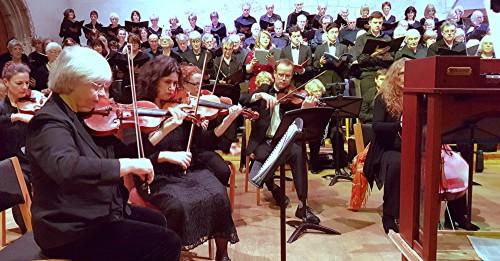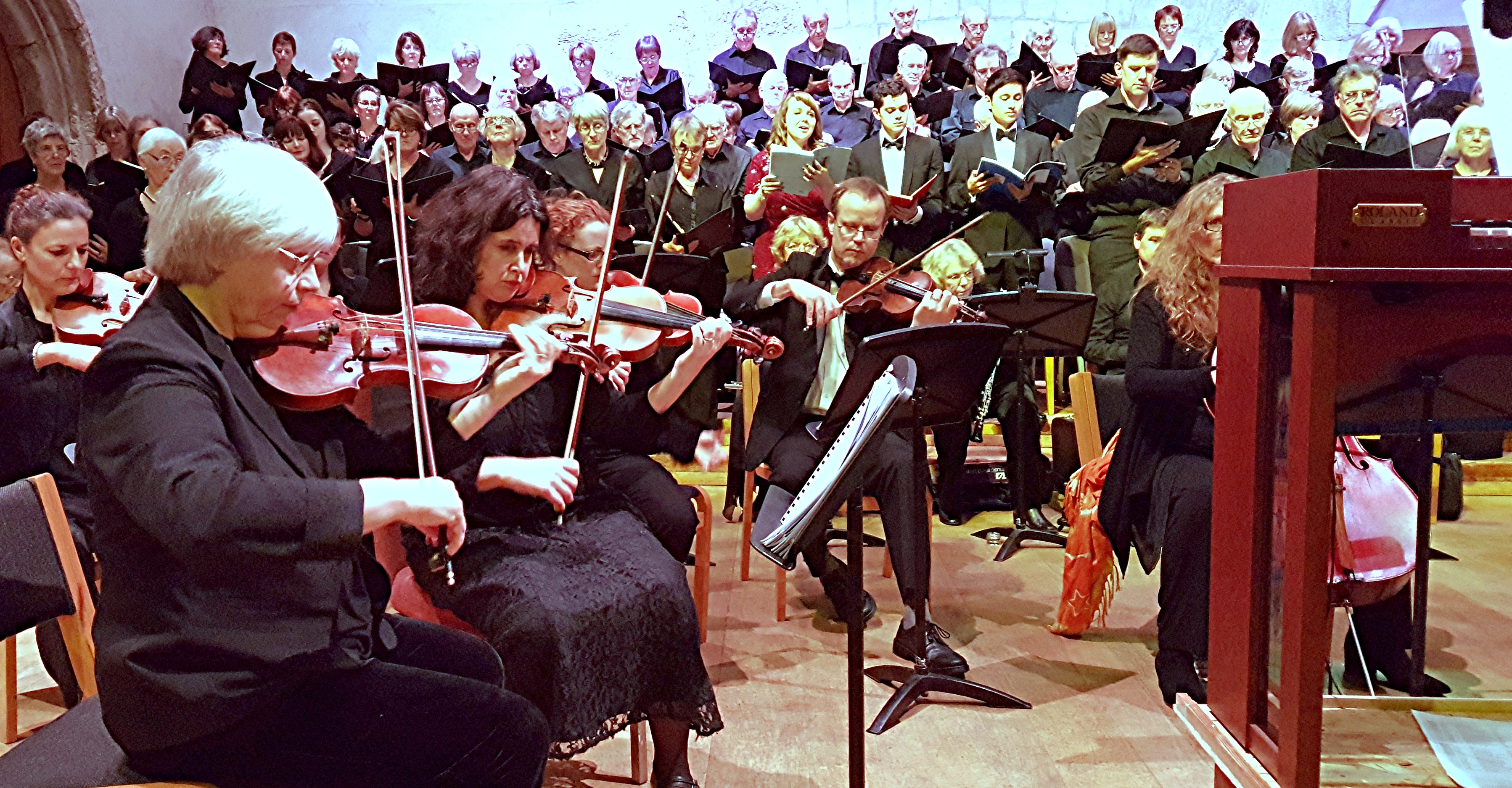 United Kingdom Haydn: Abigail Broughton (soprano), James Way (tenor), Julian Chou-Lambert (baritone), Dartington Community Choir and Dartington Sinfonietta / Simon Capet (conductor), Great Hall, Dartington, 11.12.2016. (PRB)
United Kingdom Haydn: Abigail Broughton (soprano), James Way (tenor), Julian Chou-Lambert (baritone), Dartington Community Choir and Dartington Sinfonietta / Simon Capet (conductor), Great Hall, Dartington, 11.12.2016. (PRB)

Joseph Haydn – The Seasons
If you were to ask any choir aficionado to name a large-scale oratorio by Handel, and then one by Haydn, it would be a relatively safe bet to expect Messiah and The Creation as the respective answers.
But this is to do a serious disservice to the latter composer. While The Creation (1798) is known and sung around the world, the work that followed shortly thereafter — The Seasons (1801) —has never enjoyed anywhere near the popular success of its predecessor. The suggested reasons for this are well documented, ranging from the composer’s impending old age, to dissatisfaction with specific parts of van Swieten’s libretto.
The first public performance of The Seasons was, in fact, even more successful than the debut of The Creation. While it has always attracted far less attention than The Creation, it has nonetheless always been keenly appreciated by critics. Eminent American pianist and writer on music Charles Rosen (1927-2012) calls both oratorios “among the greatest works of the century”, but judges The Seasons to be the musically more successful of the two.
Today, musical ensembles around the country — whether professional, semi-professional or amateur —share one thing in common. They all need to provide stimulating and inventive programming, but one that will equally ensure maximum audience interest and size. Furthermore, in the case of choral societies, there is the extra concern about resources on the day of the concert itself. In-house soloists are the cheapest option, and it is possible, for example, to accompany a work like Brahms’s Requiem using his own piano-duet arrangement, rather than full orchestra. When the work is decidedly less popular, though, and if anyone had read that Haydn actually “hated this, his own last work”, accountants are likely going to have a field day warning against putting on the work, in terms of potential concert revenue, against performance costs. In mitigation, it was, however, the text he “hated”. His actual verdict was “Vulgar Frenchified trash which was forced upon me”.
Dartington Community Choir was formed in 1982 and, with permission of the Dartington Trustees, has been able to use the magnificent 14th-century Great Hall on the Estate, both for rehearsals and concerts themselves. In itself, though, this is a twin-edged sword: the acoustic is magnificent, with such a high ceiling, but with the choir, orchestra and soloists inside, there is not a great deal of room left for the paying audience, and ticket prices still need to be realistic for the area.
In terms of the orchestral requirements, Haydn asks for two flutes (first doubling piccolo in one aria), oboes, clarinets and bassoons in pairs, with a contrabassoon added. The brass section is similarly extensive, needing four horns, three trumpets, alto, tenor and bass trombone. Then there are timpani, percussion and strings. Furthermore a fortepiano usually plays in recitatives, with or without other instruments from the orchestra. In addition to the four-part choir, the composer uses three solo voices to represent archetypal country folk: Simon (bass), Lucas (tenor), and Hanne (soprano).
Taking the soloists first, most similarly-sized and resourced choirs will invite young, up-and-coming professional soloists to join them for the performance. They are quick to learn, willing to participate since it is part of their overall learning experience, and it generally represents the best value for money.
A significant a number of scores for large-scale works are now available, with the orchestration skilfully trimmed, to keep as much of the original in place, yet without reflecting the fact that this is still a cheaper, cut-down version. On this occasion the decision was to go with Ian Bauers’s reduction. It loses some eleven instruments, and consists of flute, oboe, bassoon, clarinet, two horns, trumpet, timpani, percussion and strings; the latter will also be proportionally slimmed down. No continuo part is provided, but for the present performance conductor Simon Capet directed from the keyboard —an electronic substitute which he used in the recitatives, even though this involved a degree of score cross-referencing. On the day this worked a treat, though it might have been an interesting exercise to use a fortepiano sound, if available, rather than the ubiquitous harpsichord, perhaps to add a greater touch of “virtual” reality, given the period.
Of course, using this type of reduced orchestra helps solve probably the main complaint we often have at choral concerts: the choir has been rehearsing hard for months, and then, along comes the orchestra and, if left unchecked, simply drowns out most of the good work done beforehand. Conversely, though, with fewer musicians needed, especially in the wind section, each player has to be highly experienced, since the orchestration is of chamber-music dimensions, where every single note — right or wrong — tells.
But Dartington Community Choir and Capet’s work still was not finished, even before the very first note was heard. Many longer works, and especially less familiar ones like The Seasons, benefit from some judicious pruning along the way, if they are to hold the audience’s attention throughout, and not finish unfashionably late. Some minor surgery had been successfully performed, and the result worked absolutely seamlessly. Many choral societies seem to think that it is crucial for the audience to have the full text — often even in two languages — in the programme booklet. In reality, though, it is invariably too dark to follow, the font is too small, and with many words and lines repeated, it is not that relevant or helpful. The audience, unless they were in possession of a full score, would not really know or indeed care about what had been cut. This performance, sung in English, was all about the music, the music… and the music.
The event also coincided with the launch of the Dartington Sinfonietta —a new, professional symphonic ensemble that aims to provide the two counties of Devon and Cornwall, in the far South West of the UK, with orchestral concerts of the highest calibre.
From the very opening bars, here was a performance that showed everyone — singers and players — really enjoying their music-making, surely what it is ultimately all about. The choir was on top form, and it was good to hear some true voices among the soprano section in particular. That ensured that not only did each chorus have that real leading-edge feel, but pitch was also well-maintained, with singers clearly thinking above the note.
The remaining voice sections gave of their all, and maintained a good ensemble, aided in the contrapuntal passages by the clear beat from the front. The soloists — Abigail Broughton (soprano), James Way (tenor), and Julian Chou-Lambert (baritone) — were equally impressive in all they did, whether solo or in combination, and where each was able to interact with and engage the audience, so important in a venue of quite intimate size. Each soloist very much characterized their respective role through the persona of those three country-folk to great effect, and as Haydn originally intended.
The orchestral playing was especially impressive. Leader Mary Eade very much led from the front, providing secure support for a relatively sensitive number of strings. There were just three first and two second violins, two each of viola and cello, and a single bass: small, when compared with a conventional Classical string section. The blend and balance were nevertheless excellent, and there were some glorious muted pianissimos alongside really impressive fortissimos. The woodwind contribution was equally impressive, given that each of the four players was often filling in as well as accommodating their own original individual part, often in providing an obbligato in an aria or duet. Likewise the horns — often scarily isolated, with an extended range at both ends — played their part with real panache, strongly supported by the percussion section, and by lone trumpet, who appeared more by way of an occasional visitor than a rank-and-file member of the ensemble.
So much hard work had gone into making this an unmitigated success on the night that it would be somewhat invidious to single out any one faction in what was undoubtedly such a team effort. But every team needs its inspiration, motivation and leader, and in Simon Capet there could scarcely be anyone finer for the job. Add to this his most engaging demeanour, musical experience and expertise, and it becomes blindingly obvious that Dartington Community Choir, and now the new Sinfonietta, can only go from strength to strength.
The programme notes suggest that The Seasons deserves to be better known. This superb Dartington performance simply could not have done more for the cause.
Philip R Buttall
